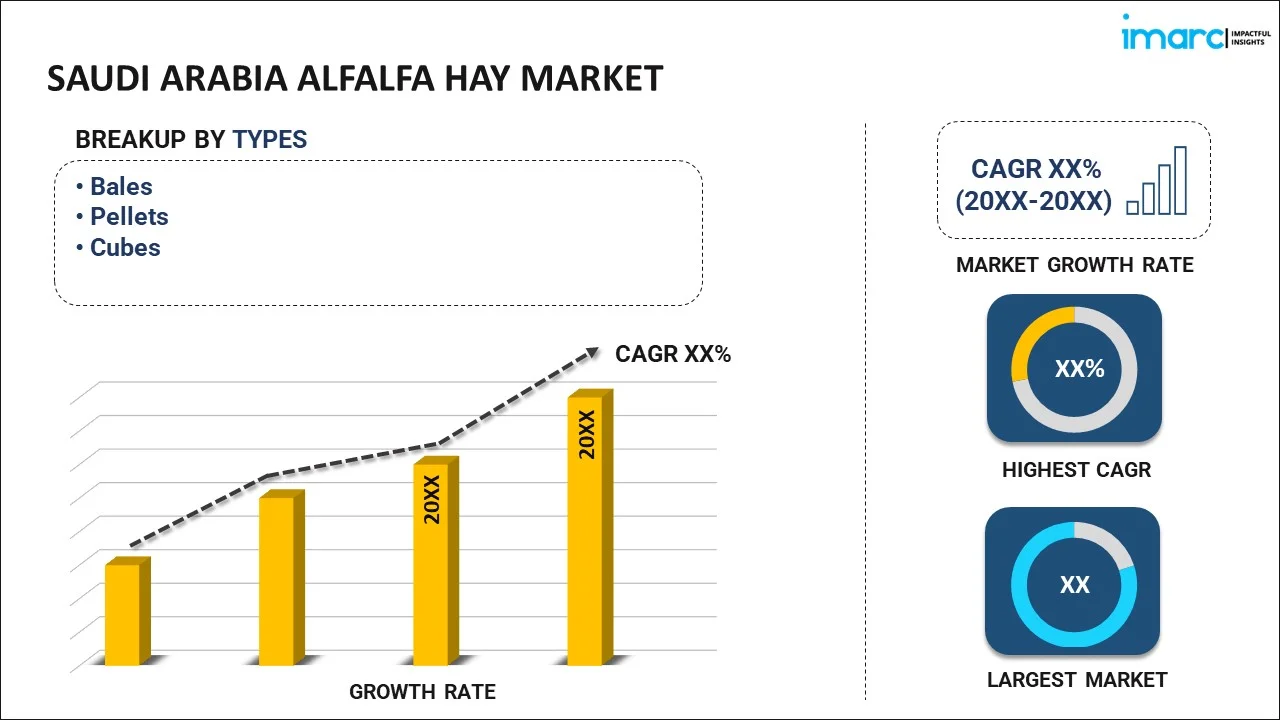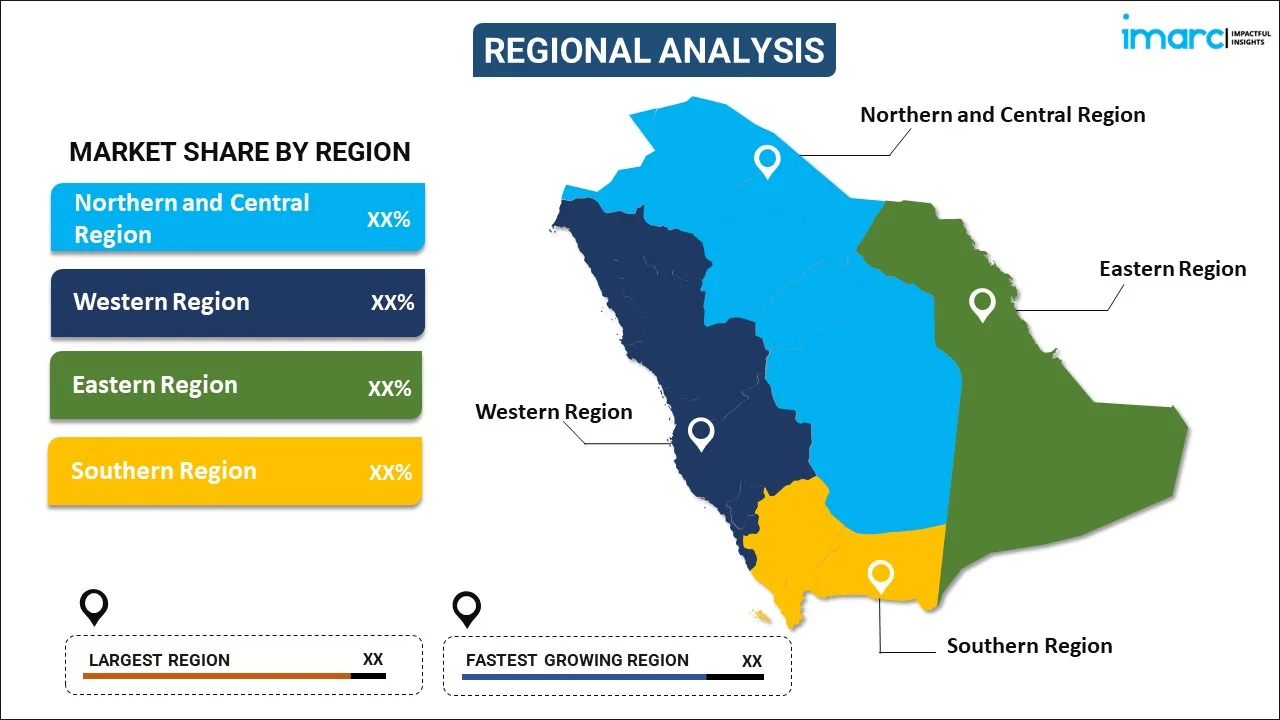
Saudi Arabia Alfalfa Hay Market Report by Type (Bales, Pellets, Cubes), Application (Dairy Animal Feed, Poultry Feed, Horse Feed, and Others), End User (Poultry, Cattle, Livestock, and Others), and Region 2025-2033
Market Overview:
Saudi Arabia alfalfa hay market size reached 2.5 Metric Tons in 2024. Looking forward, IMARC Group expects the market to reach 4 Metric Tons by 2033, exhibiting a growth rate (CAGR) of 5.2% during 2025-2033. The rising investments in R&D activities to develop water-efficient farming methods, owing to the arid climate across the country, along with the significant improvements in the field of animal husbandry, are primarily propelling the regional market.
|
Report Attribute
|
Key Statistics
|
|---|---|
|
Base Year
|
2024 |
|
Forecast Years
|
2025-2033
|
|
Historical Years
|
2019-2024
|
| Market Size in 2024 | 2.5 Metric Tons |
| Market Forecast in 2033 | 4 Metric Tons |
| Market Growth Rate (2025-2033) | 5.2% |
Alfalfa hay, commonly known as lucerne hay, serves as a forage derived from the alfalfa plant. It is an essential source of protein, fiber, vitamins, minerals, calcium, etc. Its production involves harvesting the crop with a swather and subsequently drying it in strips. Predominantly utilized in the feeding of cattle, ruminants, poultry, horses, etc., alfalfa hay also finds application in diverse agricultural practices. Beyond traditional consumption, it is cultivated for grazing, hay and silage production, and serves as both green manure and a cover crop. Distinguishing itself through a heightened nutrient profile and enhanced palatability compared to alternative grasses, alfalfa hay stands out as a key element in animal nutrition. This nutritional superiority extends to its role in the manufacturing of supplements that are widely used for fortifying the immune systems of animals, further emphasizing its multifaceted significance in supporting livestock health.
Saudi Arabia Alfalfa Hay Market Trends:
The Saudi Arabia alfalfa hay market is currently witnessing significant shifts driven by various factors and trends. One prominent driver is the increasing awareness among farmers towards the nutritional benefits of alfalfa hay in livestock feeding. Additionally, the rising emphasis on enhancing animal health and productivity is bolstering the market growth across Saudi Arabia. Apart from this, the arid climate in the country has led to the growing adoption of alfalfa varieties that can thrive in challenging weather conditions, thereby acting as another significant growth-inducing factor. Moreover, farmers are also using advanced agricultural practices and investing in innovative technologies to ensure consistent yields and high-quality alfalfa hay, thereby positively influencing the market growth in Saudi Arabia. Besides this, there is a notable trend towards sustainable agriculture, which is also bolstering the market growth. Given the scarcity of water resources in the country, the alfalfa hay market is witnessing a shift towards more efficient irrigation practices and the adoption of technologies that optimize water usage. Furthermore, in terms of international trade, the escalating demand for high-quality forage will continue to propel the Saudi Arabia alfalfa hay market over the forecasted period.
Saudi Arabia Alfalfa Hay Market Segmentation:
IMARC Group provides an analysis of the key trends in each segment of the market, along with forecasts at the country level for 2025-2033. Our report has categorized the market based on type, application, and end user.
Type Insights:

- Bales
- Pellets
- Cubes
The report has provided a detailed breakup and analysis of the market based on the type. This includes bales, pellets, and cubes.
Application Insights:
- Dairy Animal Feed
- Poultry Feed
- Horse Feed
- Others
A detailed breakup and analysis of the market based on the application have also been provided in the report. This includes dairy animal feed, poultry feed, horse feed, and others.
End User Insights:
- Poultry
- Cattle
- Livestock
- Others
The report has provided a detailed breakup and analysis of the market based on the end user. This includes poultry, cattle, livestock, and others.
Regional Insights:

- Northern and Central Region
- Western Region
- Eastern Region
- Southern Region
The report has also provided a comprehensive analysis of all the major regional markets, which include Northern and Central Region, Western Region, Eastern Region, and Southern Region.
Competitive Landscape:
The market research report has also provided a comprehensive analysis of the competitive landscape in the market. Competitive analysis such as market structure, key player positioning, top winning strategies, competitive dashboard, and company evaluation quadrant has been covered in the report. Also, detailed profiles of all major companies have been provided.
Saudi Arabia Alfalfa Hay Market Report Coverage:
| Report Features | Details |
|---|---|
| Base Year of the Analysis | 2024 |
| Historical Period | 2019-2024 |
| Forecast Period | 2025-2033 |
| Units | Metric Tons |
| Scope of the Report | Exploration of Historical Trends and Market Outlook, Industry Catalysts and Challenges, Segment-Wise Historical and Future Market Assessment:
|
| Types Covered | Bales, Pellets, Cubes |
| Applications Covered | Dairy Animal Feed, Poultry Feed, Horse Feed, Others |
| End Users Covered | Poultry, Cattle, Livestock, Others |
| Regions Covered | Northern and Central Region, Western Region, Eastern Region, Southern Region |
| Customization Scope | 10% Free Customization |
| Post-Sale Analyst Support | 10-12 Weeks |
| Delivery Format | PDF and Excel through Email (We can also provide the editable version of the report in PPT/Word format on special request) |
Key Questions Answered in This Report:
- How has the Saudi Arabia alfalfa hay market performed so far and how will it perform in the coming years?
- What has been the impact of COVID-19 on the Saudi Arabia alfalfa hay market?
- What is the breakup of the Saudi Arabia alfalfa hay market on the basis of type?
- What is the breakup of the Saudi Arabia alfalfa hay market on the basis of application?
- What is the breakup of the Saudi Arabia alfalfa hay market on the basis of end user?
- What are the various stages in the value chain of the Saudi Arabia alfalfa hay market?
- What are the key driving factors and challenges in the Saudi Arabia alfalfa hay?
- What is the structure of the Saudi Arabia alfalfa hay market and who are the key players?
- What is the degree of competition in the Saudi Arabia alfalfa hay market?
Key Benefits for Stakeholders:
- IMARC’s industry report offers a comprehensive quantitative analysis of various market segments, historical and current market trends, market forecasts, and dynamics of the Saudi Arabia alfalfa hay market from 2019-2033.
- The research report provides the latest information on the market drivers, challenges, and opportunities in the Saudi Arabia alfalfa hay market.
- Porter's five forces analysis assist stakeholders in assessing the impact of new entrants, competitive rivalry, supplier power, buyer power, and the threat of substitution. It helps stakeholders to analyze the level of competition within the Saudi Arabia alfalfa hay industry and its attractiveness.
- Competitive landscape allows stakeholders to understand their competitive environment and provides an insight into the current positions of key players in the market.
Need more help?
- Speak to our experienced analysts for insights on the current market scenarios.
- Include additional segments and countries to customize the report as per your requirement.
- Gain an unparalleled competitive advantage in your domain by understanding how to utilize the report and positively impacting your operations and revenue.
- For further assistance, please connect with our analysts.
 Inquire Before Buying
Inquire Before Buying
 Speak to an Analyst
Speak to an Analyst
 Request Brochure
Request Brochure
 Request Customization
Request Customization




.webp)




.webp)












